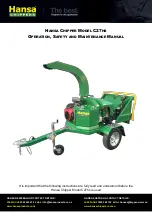
Corporate Office: 724.584.5500
Instant Access 24/7 (Parts and Service): 800.458.1960
Parts and Service
:
814.437.6861
77
Table 33 – Fill Water Chemistry Requirements
Water Characteristic
Quality Limitation
Alkalinity (HCO
3
-
)
70-300 ppm
Aluminum (Al)
Less than 0.2 ppm
Ammonium (NH
3
)
Less than 2 ppm
Chlorides (Cl
-
)
Less than 300 ppm
Electrical Conductivity
10-500µS/cm
Free (aggressive) Carbon
Dioxide (CO
2
)†
Less than 5 ppm
Free Chlorine(Cl
2
)
Less than 1 PPM
HCO
3
-
/SO
4
2-
Greater than 1.0
Hydrogen Sulfide (H
2
S)*
Less than 0.05 ppm
Iron (Fe)
Less than 0.2 ppm
Manganese (Mn)
Less than 0.1 ppm
Nitrate (NO
3
)
Less than 100 ppm
pH
7.5-9.0
Sulfate (SO
4
2-
)
Less than 70 ppm
Total Hardness (dH)k
4.0-8.5
* Sulfides in the water quickly oxidize when exposed to air;
therefore ensure agitation does not occur when taking a water
sample. Unless tested immediately at the site, the sample will
require stabilization with a few drops of one Molar zinc acetate
solution, allowing accurate sulfide determination up to 24 hours
after sampling. A low pH and high alkalinity cause system
problems, even when both values are within the range shown. The
term pH refers to the acidity, basicity, or neutrality of the water
supply. Below 7.0, water is acidic. Neutral water contains a pH of
7.0.
† Dissolved carbon dioxide calculation is from the pH and total
alkalinity values shown below or measured on the site using a test
kit.
Dissolved Carbon Dioxide, PPM = TA x 2
[(6.3-pH)/0.3]
where TA =
Total Alkalinity, PPM as CaCO
3
Table 34 - Recommended Glycol Solutions
Chilled Water
Temperature
Percent Glycol
By Volume
50°F (10°C)
Not required
45°F (7.2°C)
5 %
40°F (4.4°C)
10 %
35°F (1.7°C)
15 %
30°F (-1.1°C)
20 %
25°F (-3.9°C)
25 %
20°F (-6.7°C)
30 %
CAUTION: When your application requires the
use of glycol, use industrial grade glycol
specifically designed for heat transfer systems
and equipment. Never use glycol designed for
automotive applications. Automotive glycols
typically have additives engineered to benefit
the materials and conditions found in an
automotive engine; however, these additives can
gel and foul heat exchange surfaces and result in
loss of performance or even failure of the chiller.
In addition, these additives can react with the
materials of the pump shaft seals resulting in
leaks or premature pump failures.
WARNING: Ethylene Glycol is flammable at
higher temperatures in a vapor state. Carefully
handle this material and keep away from open
flames or other possible ignition sources.
Step 3 - Check Condenser
There are two possible types of condensers present
in the chiller: water-cooled, and remote air-cooled. It
is important to verify the chiller will have adequate
condenser cooling for proper chiller operation.
Water-Cooled Condenser Check
Check the condenser water lines to make sure all
connections are secure. Make sure sufficient
condenser water flow and pressure are available, the
condenser water supply is turned on, and all shut-off
valves are opened. The electronic water regulating
valves ship in the closed position and open after
enabling the circuit.
Remote Air-Cooled Condenser Check
Check the refrigerant lines to make sure all
connections are secure and that a proper evacuation
of the chiller, the field piping, and the remote
condenser has occured. Verify the refrigeration
piping has been installed as descibed in the
installation section of this manual. Check the remote
condenser main power and control wiring to ensure
all connections are secure.
Step 4 – Check Refrigerant Valves
During shipment or installation it is possibe valves
where closed. Verify that all refrigerant valves are
open.
CAUTION: Do not operate the unit with the
compressor, oil line, or liquid line service valves
“CLOSED”. Failure to have these “OPEN” may
cause serious compressor damage.









































